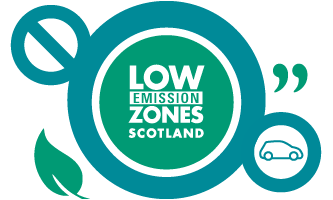About Low Emission Zones

A Low Emission Zone (LEZ) is an area which sets an environmental limit on certain city roads, restricting access for the most polluting vehicles to improve air quality. This helps protect public health within cities, making them more attractive places in which to live, work and to visit. Vehicles that do not meet the emission standards set for a LEZ may be subject to a penalty charge notice.
Scotland’s LEZs were introduced on 31 May 2022 with Glasgow beginning enforcement on 1 June 2023, Dundee on 30 May 2024, and Aberdeen and Edinburgh on 1 June 2024.
The geographic extent, scope, timescales for implementation of Scotland’s LEZs were determined by each local authority.
Why do we need Low Emission Zones?
Air pollution in Scotland has reduced over recent years, however air quality remains an issue in a number of hotspots in Scotland’s towns and cities, predominantly due to road transport.
Poor air quality has a negative impact on all of our health, but we know that the very young, the elderly and those with pre-existing health conditions are particularly vulnerable.
LEZs set an environmental limit on certain road spaces, restricting access for the most polluting vehicles to improve air quality. LEZs help to protect public health and support Scotland in successfully meeting air quality legal limits.


What are the benefits of Low Emission Zones?
LEZs help to protect public health by improving air quality, as well as delivering various health, environmental and economic benefits, including:
Health
- Outdoor air pollution is one of the greatest environmental risks to human health and one of the main avoidable causes of death and disease globally. In Scotland, long-term exposure (over years or a lifetime) to outdoor air pollution is estimated to have an effect equivalent to 1,800 to 2,700 deaths a year (Mitsakou et al 2022)*. But its impacts go even further, being a major contributor to ill health, with impacts on health across the life course. Outdoor air pollution can cause and worsen health effects in all individuals, particularly society’s most vulnerable populations – including, children, older people, those with underlying health conditions.
- Policies and actions tackling outdoor air pollution can offer wider public health and wellbeing co-benefits, including increased physical activity, noise reduction, greater road safety and climate change mitigation.
For more information about the health and wellbeing impacts of outdoor air pollution, please visit:
- Outdoor air pollution | NHS inform
- Scale of the problem - Overview - Outdoor air pollution and health - Environmental health impacts - Population health - Public Health Scotland
Environment
- Can help reduce pollution from vehicle emissions.• help to accelerate the uptake of lower emission vehicles – and cleaner vehicles. Also benefit all areas the vehicles travel through – not just the LEZ. As cleaner LEZ compliant vehicles are adopted and travel beyond the LEZ boundary the benefits of lower emission vehicles will extend further than the zones.
- Encourage people to consider using more public transport and active travel methods instead of driving.
For more information on what Scotland is doing to reduce transport emissions and encourage more sustainable ways to travel visit netzeronation.scot.
Economy
- Can help improve air quality and protect public health within towns and cities. This makes them more attractive places to live, work and to visit.
